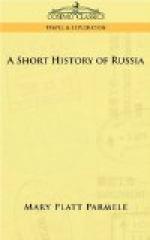When Vladimir died, in 1015, the partition of his dominions among numerous heirs inaugurated the destructive system of Appanages. The country was converted into a group of principalities ruled by Princes of the same blood, of which the Principality of Kief was chief, and its ruler Grand Prince. Kief, the “Mother of Cities,” was the heart of Russia, and its Prince, the oldest of the descendants of Rurik, had a recognized supremacy over the others; who must, however, also belong to this royal line. No prince could rule anywhere who was not a descendant of Rurik; Kief, the greatest prize of all, going to the oldest; and when a Grand Prince died, his son was not his rightful heir, but his uncle, or brother, or cousin, or whoever among the Princes had the right by seniority. This was a survival of the patriarchal system of the Slavs, showing how the Norse rulers had adapted themselves to the native customs as before stated.
So while in thus breaking up the land into small jealous and rival states independent of each other—with only a nominal headship at Kief—while in this there was a movement toward chaos, there were after all some bonds of unity which could not be severed: A unity of race and language; a unity of historical development; a unity in religion; and the political unity created by the fact that all the thrones were filled by members of the same family, any one of whom might become Grand Prince if enough of the intervening members could—by natural or other means—be disposed of. This was a standing invitation for assassination and anarchy, and one which was not neglected.
Immediately upon the death of Vladimir there commenced a carnival of fraternal murders, which ended by leaving Yaroslaf to whom had been assigned the Principality of Novgorod, upon the throne at Kief.
The “Mother of Russian Cities” began to show the effect of Greek influences. The Greek clergy had brought something besides Oriental Christianity into the land of barbarians. They brought a desire for better living. Learning began to be prized; schools were created. Music and architecture, hitherto absolutely unknown, were introduced. Kief grew splendid, and with its four hundred churches and its gilded cupolas lighted by the sun, was striving to be like Constantinople. Not alone the Sacred Books of Byzantine literature, but works upon philosophy and science, and even romance, were translated into the Slavonic language. Russia was no longer the simple, untutored barbarian, guided by unbridled impulses. She was taking her first lesson in civilization. She was beginning to be wise; learning new accomplishments, and, alas!—to be systematically and judicially cruel!
Nothing could have been more repugnant or foreign to the free Slav barbarian than the penal code which was modeled by Yaroslaf upon the one at Byzantium. Corporal punishment was unknown to the Slav, and was abhorrent to his instincts. This seems a strange statement to make regarding the land of the knout! But it is true. And imprisonment, convict labor, flogging, torture, mutilation, and even the death penalty, came into this land by the way of Constantinople.




